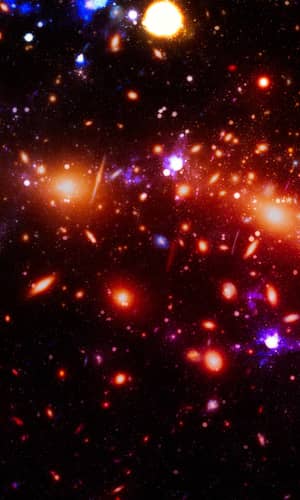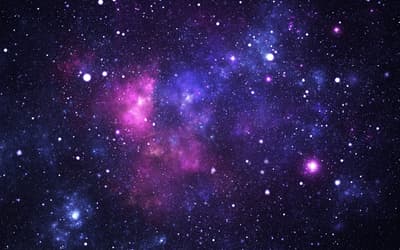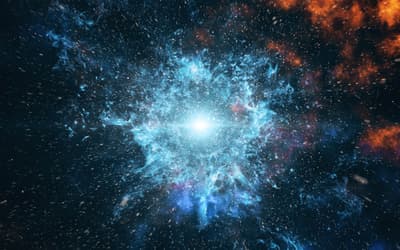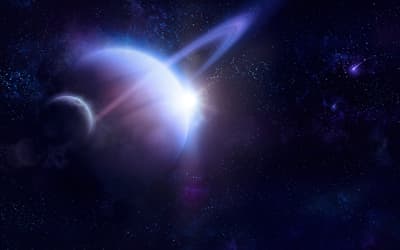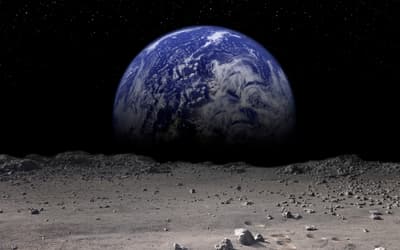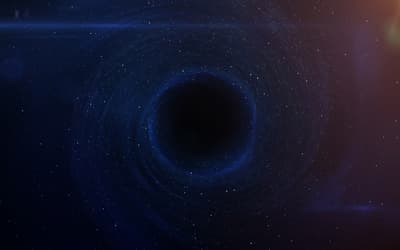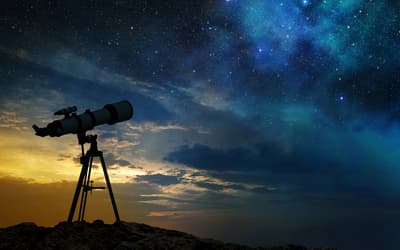The views expressed in this paper are those of the writer(s) and are not necessarily those of the ARJ Editor or Answers in Genesis.
Abstract
I speculate on a new cosmological redshift mechanism due to “tired light” in a created static-yet-unstable 6000-year-old finite-size universe. This utilizes Lisle’s Anisotropic Synchrony Convention (ASC) model, but I show a one-to-one correspondence with the Hartnett-Carmeli model that was so successful when tested against type Ia supernova measurements. This gives a theoretical underpinning to the ASC model with a Hubble law redshift-distance dependence, but not from expansion, yet where, today, we see all sources in the universe only 6000 years after they were created.
Keywords: redshift mechanism, tired light, static or expanding universe, creationist cosmology
Introduction
In standard cosmology it is normal practice to assume no Creator and that the material world is all that there is. Therefore it follows that only the laws of physics, time, and chance are to be considered when formulating a description of the creation and history of the universe we see. This means that within the visible horizon there has been sufficient time for the gravitational and electromagnetic influences2 of the matter elsewhere to be felt locally. Assuming an expanding universe, the only limitation comes from the notion that the universe has expanded faster than the speed of light (c)3 and therefore this has introduced to the Cosmic Microwave Background (CMB) radiation what is known as the horizon problem (Hartnett 2014a).
It is implicitly assumed that redshifts, seen in the light from extragalactic sources, correctly describe an expanding universe and that any past epoch in the history of the universe can be defined by its redshift. This is because the Hubble law is explained via the hypothesis of stretching of the wavelengths of light emitted from the galaxies as they recede from us.4
It thus follows from this assumption that any region of space characterized by a particular redshift5 had a history back to the big bang. This might not be immediately obvious to the casual observer but this assumption is tied to redshifts defining an expanding universe, which began from a single point and expanded to all that we see today. Hence it follows that all epochs one observes, via the regions of space defined by the redshifts of the galaxies within those regions, are representative of all past epochs for regions that cannot be observed.6 It follows, therefore, from the assumption of the cosmological principle, that the history assumed by inspecting a sequence of redshift regions is typical for all regions in the universe.
A similar idea can also be assumed for a static universe where redshift is a measure of distance, but quite obviously not due to expansion. I have recently discussed the notion of expansion of space and expansion of the universe, which are not necessarily the same thing, but both lead to the idea that cosmology is more philosophy than science (Hartnett 2014b). Also I have taken another look at the biblical creationist light-travel-time problem (Hartnett 2015) to which this paper is a sequel.
Non-Equilibrium Universe
What I speculate about here is the idea that what we observe in the universe is not in equilibrium, that is, the state of the universe is in a transient state. It is a universe just freshly created. That of course implies a fair amount of “mature creation” from the Creator. But the physics we interpret from the observations of the cosmos, might be better interpreted by assuming it is still in a non-equilibrium condition. One example of this may be the anomalous rotation curves observed in thousands of spiral galaxies. When a spectrograph is placed on the emissions across the disk regions of a spiral galaxy, redshifted and blueshifted spectral lines are observed on opposite sides of the central nucleus. This is (correctly, in my opinion) interpreted as rotation of the galaxy, and the red and blueshifted lines are due to the Doppler Effect in the light from the gases in the disk regions. However, at large distances from the nucleus, the rotation speeds of the disk gases and stars is much too fast compared to what is expected using standard Keplerian physics. At those rates of rotation the galaxies would disintegrate—fly apart—in a matter of a hundred million years. But if the universe is only 6000 years old this is not a problem.
Those rotation curves are currently interpreted as requiring massive amounts of halo dark matter to keep the galaxies stable over their lifetimes of ten billion years or so. The implicit assumption is that they have built themselves up over the assumed age of the universe by accumulating matter from elsewhere (mergers etc.) but always resulting in a stable gravitational condition. Essentially this is the cosmic equivalent of geological uniformitarianism. The belief that what we observe now has been going on for billions of years into the past. But what if that is not the case?
Our own sun is a good example, too. Radiation from the core to the surface should take about 10,000 to 170,000 years to get to the surface (NASA 2007), yet only 8.3 minutes to get to earth. Adam saw the sun, therefore light already was at its surface within 2 days of its creation, and I think we can infer it was able to be seen on the same day of its creation. That is what I would argue is the central reference point of the whole Creation Week.7
Another assumption that is made when modelling the universe is the cosmological principle. In particular, the assumption is that the universe we observe around us is just a time advanced version of any other part of the universe. This means that there is no special place in the universe; there is no centre and no edge. Thus it is assumed that our galaxy is not in any special place.
But what if all that is wrong? What if our galaxy, at least, is cosmologically somewhere near the centre of the universe, which is finite and bounded and hence has both an edge and a centre? The universe does not appear to be in any sort of an equilibrium condition, so what if the created universe is nonhomogeneous but isotropic around a unique centre with a finite extension?
One argument some use against this idea is that it would be unstable and collapse into its centre. That could even be possible, but not if we are only at the 6000 year mark in its history. Who says a created universe needs to be stable against collapse? Nevertheless it could be, but the point is, why is that even a requirement? It is a uniformitarian assumption.
Hubble on Redshifts
Edwin Hubble observed a systematic trend between the redshifts of galaxies and their distances from earth. This result was interpreted to mean that the universe is expanding.
Now Hubble was not a believer in the Creator, but rather that the universe was the product of random chance and the laws of physics. His measurements indicated that the galaxy redshifts are proportional to their distances from earth, which seemed to strike him as quite significant. So in 1937 he wrote,
Such a condition would imply that we occupy a unique position in the universe . . . But the unwelcome supposition of a favored location must be avoided at all costs . . . . [it] is intolerable; moreover, it represents a discrepancy with the theory because the theory postulates homogeneity. (Hubble 1937, pp. 50–59)
What prompted this comment was that he believed he was seeing galaxies in all directions speeding away from him by the same proportion, that is, the more distant the faster they moved. Understand though, the redshifts were only inferred as being caused by the recession speed of the galaxies. Astronomers then often spoke like that, as if it due to the Doppler Effect, but most now believe it is due to the cosmological expansion of the universe (Hartnett 2014b).
One way you could interpret those observations is that we are at the centre of the universe and the galaxies are all receding away from us.8 However Hubble rejected that concept on philosophical grounds. He went on to say:
Therefore, in order to restore homogeneity, and to escape the horror of a unique position, the departures from uniformity, which are introduced by the recession factors, must be compensated by the second term representing the effects of spatial curvature. (Hubble 1937, p. 59)
He resorts to curvature of space. By assuming that space is curved a centre could be avoided. Thus there is no need for a centre or an edge to the universe. Thus it follows that we are not in a unique position in the universe and the cosmological principle can be saved.
Prior to these aforementioned comments from his 1937 book, Hubble, in 1935, expressed the following concern.
. . . the possibility that red-shift may be due to some other cause, connected with the long time or distance involved in the passage of the light from the nebula to observer, should not be prematurely neglected. (Hubble and Tolman 1935, p. 303)
He was suggesting that there could be other mechanisms causing light to be redshifted, besides recession of the galaxies due to the Doppler Effect or cosmological expansion; a mechanism possibly resulting from the passage of light through the vast distances of the cosmos.
Again by 1947 Hubble was to express doubts about an expanding universe. His own Hubble law says that the further away the object, the greater the redshift. But it seems, at least by this time in his life, he did not strongly believe in the notion of the expanding universe and wrote that redshifts result from some hitherto-undiscovered mechanism (Hubble 1947).
A Possible Redshift Mechanism
It is always difficult to know exactly what was in the mind of some past scientist, who may have changed his view from time to time. But the notion of some other mechanism to explain the overall systematic trend of redshifts in galaxies is worth considering.
Previously I have discussed the idea of Halton Arp’s intrinsic redshifts, and there is a lot of evidence to support the notion that quasars have large redshifts which are not related to their distance in the universe (Hartnett 2003a, 2013a, 2014c).
I speculate here on a redshift mechanism, a “tired light” mechanism. Tired light is not new,9 and was probably first suggested by Fritz Zwicky in 1929 (Zwicky 1929). But this tired light mechanism that I propose here is a direct consequence of creation.
Scripture tells us (emphases added):
Lift up your eyes to the heavens, and look upon the earth beneath: for the heavens shall vanish away like smoke, and the earth shall wax old like a garment, and they that dwell therein shall die in like manner: but my salvation shall be for ever, and my righteousness shall not be abolished. (Isaiah 51:6 KJV)
Of old hast thou laid the foundation of the earth: and the heavens are the work of thy hands. They shall perish, but thou shalt endure: yea, all of them shall wax old like a garment; as a vesture shalt thou change them, and they shall be changed: . . . (Psalm 102:25, 26 KJV)
Which is quoted in the book of Hebrews (emphases added):
And, Thou, LORD, in the beginning hast laid the foundation of the earth; and the heavens are the works of thine hands: They shall perish; but thou remainest; and they all shall wax old as doth a garment; And as a vesture shalt thou fold them up, and they shall be changed: but thou art the same, and thy years shall not fail. (Hebrews 1:10–12 KJV)
The suggestion here in Scripture is that the heavens, the starry cosmos, is not here forever; it is not eternal, and at some future date God will “fold up” the heavens like He is folding up and putting away a tent. Scripture is quite clear that the heavens shall not endure but shall vanish away. The Bible also describes the stars “melting” or “dissolving,” which I have previously suggested could relate to comets melting as they approach the sun (Hartnett 2006), but also it could have meaning in regards to the end of the stars, as they are destroyed in the collapse of this universe (Hartnett 2003b).
But the day of the LORD will come . . . the heavens shall pass away with a great noise, and the elements shall melt with fervent heat, the earth also and the works that are therein shall be burned up. . . . Looking for and hasting unto the coming of the day of God, wherein the heavens being on fire shall be dissolved, and the elements shall melt with fervent heat? (2 Peter 3:10, 12 KJV) (emphasis added)
And all the host of heaven shall be dissolved, and the heavens shall be rolled together as a scroll: and all their host shall fall down, . . . (Isaiah 34:4 KJV) (emphasis added)
The suggestion here then is that the universe was created by God in an inherently unstable condition. It was only the sustaining power of God that could hold it in place. But since the curse that power has been withdrawn, and the whole universe is headed for destruction and collapse. God had foreknowledge of the choices man would make anyway. In other words, we should not make the implicit assumption that the universe was designed to be in a stable equilibrium condition and remain so forever.
Nevertheless, the universe is ruled by the inexorable laws of thermodynamics. It has a finite energy content and is trending to follow the path that those laws (God’s creation) set. As part of that wearing out (“waxing old”) process (second law of thermodynamics; Hebrews 1:11) photons began losing energy from their creation about 6000 years ago.
My proposal has two important features,
- All photons, which we observe from the distant cosmos, were created at the beginning of the universe about 6000 years ago;
- The energy of all photons, of initially any wavelength, exponentially decays with the same characteristic time constant.
A “Tired Light” Model
Let’s suppose the most distant sources have a redshift of zmax and that all photons at frequency 𝜈 with initial energy h𝜈0 lose energy such that at any time (t) measured from their moment of creation,
where t advances from the moment of creation, and T is a characteristic time constant. The initial photon frequency 𝜈0 is measured in the source rest frame while 𝜈 is measured in the observer rest frame with time t = r/c, where r is the distance travelled and c represents the canonical speed of light.
The tired light model suggested by Zwicky was of the form,
where δ = c/H0 is a characteristic distance, the Hubble distance (about 13.8 billion light-years). The parameter H0 is the Hubble constant. Zwicky (1929, p. 778) has my form of the Zwicky equation in differential form.
It was suggested that the photon’s interaction with the vacuum during its flight is not a lossless process, but that scattering causes losses and hence an increase of wavelength. Criticism has been that such interactions should not result in a straight path for light and hence blur the images, and also that it would introduce a frequency dependence, a dispersion, neither of which are observed (Hartnett 2014d).
A more recent paper (Urban et al. 2013) however, provides support for the idea that the finite speed of light (c) is determined by an interaction with the ephemeral particles in the quantum vacuum. This occurs at the sub-atomic Compton wavelength energy scale. The photon travels at a bare infinite speed between interactions with fermion pairs in the vacuum, which slow its progress to speed c. Such an idea was once suggested by Dicke (1957).
If this is valid then it would follow straight paths (within current measurement limits) and in the Urban et al. (2013) model it is non-dispersive for all wavelengths. However the latter assumes it does not exchange energy or momentum with the vacuum, just retards its progress, that is, it is lossless. But over cosmological distances that is impossible to verify. I only speculate that the interaction, which impedes the speed of the photons also causes a miniscule loss of energy to the vacuum. This is not unreasonable as there are no other known lossless scattering processes in nature. That miniscule loss then accumulates along the very long interaction path the photons take to reach earth from distant cosmic sources. The energy of a photon as a fraction of its initial energy (h𝜈/h𝜈0) travelling through space from a distant source, with redshift z = 10, arrives with about only 9% of its initial photon energy after travelling a distance of 13.8 billion light-years in a time of 2.4 T.
From equation (1) we can determine the redshift (z) of any distant source is given by,
The beginning of time measured backwards in cosmic time from the present is t0.10 Therefore the maximum redshift possible is,
which means the characteristic time constant T = t0/ ln(1 + zmax) where t0 ≈ 13.8 billion years.11 Thus assuming a maximum redshift zmax = 10 for the most distant sources means T ≈ 5.75 billion years (as would in principle be measured by local earth clocks) (Ellis et al. 2012).12 Thus, in terms of the Zwicky model but redefining the distance scale as, δ = c T, means δ = 5.75 billion light-years under the same assumption zmax = 10. This value is tentative; I am not claiming this as a prediction, just stating some upper limit to redshifts, from the assumption that the universe had a beginning, not from a singularity (Hartnett 2014e), and is finite in extension and even bounded.
Losses Per Unit Distance
If the photons lose 1/e of their energy after travelling for δ = 5.75 billion light-years, then their energy loss is 0.06 ppb/light-year. Since photons are all continually moving and interacting with the vacuum this means they lose their fractional energy at the rate of 2 × 10–18/s (Poli et al. 2013). Current state-of-the-art optical clocks are beginning to approach this sort of precision and have the accuracy for measuring shifts in spectral lines over real time, near this level.13 But the precision astronomical redshift measurements would have to be at this level to measure the evolution of the line in real time. Currently redshifts are measured at about the 1% level (10,000 ppm) in robot astronomy surveys but in individual cases the best spectroscopy has yielded redshift measurements down to the 10 ppm level. If the latter could be achieved in a 1 s sampling time it would still be about 13 orders of magnitude away from detecting the effect described here. If the spectroscopy could average for 10,000 s and still maintain a coherent signal14 that would reduce the margin another 4 orders of magnitude, but still way beyond the reach of human technology to measure in the foreseeable future.
Cosmic Creation Processes
In the cosmos we see processes from creation Day 4 only 6000 years after creation if all objects in the universe are only 6000 years old. Stars and galaxies, like our own sun are 6000 years old. Under the assumption of the Einstein Synchrony Convention (ESC) (Hartnett 2013b), the travel time of light at constant c (the canonical two-way speed of light) may be up to many billions of years, but all light originally arrived at the earth for the first time on Day 4 of Creation Week. Under the alternative assumption of the Asynchronous Synchrony Convention (ASC) the one-way speed of light towards us may be assumed to be infinite, that is, there is no travel time. Thus we see all events in the cosmos as they are happening, or, they are time-stamped by the moment the light arrives at the earth under the ESC (Hartnett 2014f, g). But this is a choice of convention. Since the one-way speed of light has no physical meaning in the universe, under the ASC this means we are free to choose our timing convention (see Hartnett 2015 for a more detailed discussion).
In this worldview, we are at most seeing events in the cosmos only 6000 years after the conclusion of the Day 4 of Creation Week. Therefore on the timescales inherent in the cosmos, this is an extremely brief period. For example, at the current measured (constant) rotation speed spiral galaxies should rotate once in about 200 million earth years, if there was that time available to them. Therefore allowing for a mature creation in much of the cosmos, we are seeing it in a state that is very close to what it was when God finished creating it.
It should be added though, that what an astronomer defines as a measure of age, like the spiral structure of galaxies, or the sequence of stars in the Hertzsprung-Russell diagram,15 depends on implicit uniformitarian assumptions. But these are externally imposed measures of age, based on the observer’s worldview. No doubt some content of mature creation (what appears to be mature based on this arbitrary human perceived definitions of age) is necessary in this cosmology, as it is in nearly all creationist cosmologies. Day 4 of Creation Week necessarily involves some mature content, for example, our own sun; no one would assume it started in some embryonic condition, but that God created it essentially as it is seen today. Also some form of mature creation might be expected with the formation of other stars as well as galaxies. Here I conjecture that quasar redshifts result from large energy loss to the vacuum due to conditions in their creation process (Hartnett 2005).
In terms of the creation processes on Day 4 with quasar ejections at speed u one can estimate that in 6000 years since then about 6000∙u/c years of process has occurred. If ejection velocity u = 0.1 c (from the Arp-type hypothesis), then their locations would be out to 600 light-years from their parent galaxies, assuming uniform motion. If non-uniform motion, then their distances could be larger but less than 6000 light-years, assuming u = c, even for an initial plasmoid of zero inertial mass under the Hoyle-Narlikar variable mass hypothesis (Hoyle and Narlikar 1974; Narlikar and Arp 1993; Narlikar and Das 1980). The Hoyle-Narlikar variable mass hypothesis is a possible explanation for the creation of new matter through galaxy or quasar ejections from other galaxies, which also results in a quantized intrinsic redshift component (Hartnett 2003a).
However based on ejections at the speed of light c the maximum distance a quasar could travel out from its parent in 6000 years is about 2 kpcs, which is a lot less than the typical size of a galaxy. Since the hypothesis involves zero inertial mass during the creative process when God is creating this matter in the centres of active galaxies, on Day 4, when current laws of physics may not be all in operation, one might imagine/conjecture superluminal ejections (u > c) initially, followed by retardation only after Day 4 is over. With that came the introduction of the impedance of the vacuum, which caused large losses of energy to the vacuum and hence the large redshifts. So those large redshifts are largely not due to the travel of the photons to earth, but the latter would contribute a small component (z) from equation (3) to the measured redshifts of the quasars (z0) as follows:
where z here is the redshift of the parent galaxy and zQ is some intrinsic redshift associated with the quasar resulting from its creation. For small z the measured redshift z0 ≈ zQ. Equation (5) is derived by the product of energy losses from two different processes, where each process (i) contributes as (1 + zi) to the measured redshift (1 + z0) (Fulton and Arp 2012; see also Arp, Fulton, and Roscoe 2005).
Correspondence to the Carmeli Model
In my book Starlight, Time and the New Physics (Hartnett 2010) I attempt to use Carmeli’s cosmology to explain some physics in the universe without invoking fudge factors. Here let us consider the simplest Carmeli metric,
where dr2 = (dx1)2 + (dx2)2 + (dx3)2; only radial distances are considered, angular terms can be suppressed with isotropy. The parameter τ is the Hubble-Carmeli time constant in an expanding universe, dv is the infinitesimal expansion speed of the universe, dt is the infinitesimal time element for local atomic time.
The expansion is encoded in the velocity-dimension, which in reality represents redshift space (z) not motion of galaxies through physical space. Now consider that Carmeli posited that his spacevelocity universe arises when one assumes dt = 0, because what we see in the universe is like taking a still photograph.
In such a case, equation (6) becomes a spacevelocity equation with no time dependence, hence static. And I found that the formulation where matter is included, tests very well against the high redshift type Ia supernova measurements without the need for dark energy (DE) or dark matter (DM) (Hartnett 2008). Recently this was confirmed (Oliveira 2014) where an author even added dark matter and dark energy as free parameters, but the best fit was achieved where their sum was set to zero (DE + DM = 0).
In the case of my type Ia supernova tests, they were on the redshift-distance (actually luminosity) dependence (Hartnett 2008). So if redshifts for the host galaxies of those supernovae have a Hubble-law–type distance dependence then it does not necessarily imply an expanding universe. All then the Carmeli formulation is doing is testing that redshift dependence against luminosity in the cosmos. So it could apply to a static universe also.
As stated by setting dt = 0 in equation (6) we derive the (linearized) Carmeli spacevelocity metric. But doing this is equivalent to defining the one-way speed of light as infinite towards the observer. This is not some measurable quantity as has been addressed before. It is only by a convention (Lisle 2010; Newton 2001). In this case the convention is determined by the choice of time coordinates. But in equation (6) the measurable two-way speed of light is a universal constant c.
If this is true then it also follows that the successful fit to the data of the high-redshift type Ia supernova measurements, which has been demonstrated via Carmeli’s spacevelocity cosmology, is true also in this static universe, provided that the Hubble law still holds.
But of course this redefines the meaning of the velocity dimension in the Carmeli metric, resulting in a new theory entirely. The important difference is the interpretation we place on Carmeli’s velocity dimension. Instead, in this paper, I interpret it as a redshift dimension, yielding a distance-redshift relationship for the cosmos.16 I could speculate that this redshift dimension is something like an additional time dimension. Possibly time is really a vector, where locally we experience only one scalar component?
From the metric of equation (6) where we choose the convention of dt = 0 it naturally follows that it is as if we are observing light with an infinite towards-the-observer one-way speed.17 Hence no light travel time problem, in a cosmology with a clear explanation for measured data, without the need to include the fudge factors such as dark energy, dark matter, inflation, and the expansion of space.
Conclusion
Taken together, this paper and its prequel (Hartnett 2015) provide different aspects of a creationist cosmogony consistent with the biblical history in Genesis. It is an extension of the Lisle ASC model. Here I speculate on the possibility of a “tired light” mechanism in a static universe, which is not ruled out by any known physics. This universe is finite in extension and not in equilibrium. Only God’s sustaining power need uphold this universe; in any case, I believe that was removed at the curse and the universe will eventually be “rolled up,” or changed by God as he promised.
References
Arp, H., C. Fulton, and D. Roscoe. 2005. Periodicities of quasar redshifts in large area surveys. http://arxiv.org/pdf/astroph/0501090v1.pdf.
Dicke, R. H. 1957. Gravitation without a principle of equivalence. Reviews of Modern Physics 29, no. 3:363–376.
Ellis, R. S., R. McClure, J. Dunlop, B. Robertson, O. Usher, and D. Pierce-Price. 2012. Hubble census finds galaxies at redshifts 9 to 12. http://www.spacetelescope.org/news/heic1219/.
Fulton, C. C., and H. C. Arp. 2012. The 2dF redshift survey. I. Physical association and periodicity in quasar families. Astrophysical Journal 754, no. 2:134–143.
Hartnett, J. G. 2003a. The heavens declare a different story. TJ 17, no. 2:94–97. http://creation.com/the-heavens-declare-a-different-story.
Hartnett, J. G. 2003b. Look-back time in our galactic neighbourhood leads to a new cosmogony. TJ 17, no. 1: 73–79. http://creation.com/images/pdfs/tj/j17_1/j17_1_73-79.pdf.
Hartnett, J. G. 2005. Creative episodes in a creationist cosmology. TJ 19, no. 3:108–115. http://creation.com/images/pdfs/tj/j19_3/j19_3_108-115.pdf.
Hartnett, J. G. 2006. The ‘waters above.’ Journal of Creation 20, no. 1:93–98. http://creation.com/the-waters-above.
Hartnett, J. G. 2008. Extending the redshift-distance relation in cosmological general relativity to higher redshifts. Foundations of Physics 38, no. 3:201–215. http://arxiv.org/pdf/0705.3097v2.pdf.
Hartnett, J. 2010. Starlight, time and the new physics. 2nd ed. Atlanta, Georgia: Creation Book Publishers.
Hartnett, J. G. 2011a. Does observational evidence indicate the universe is expanding?—part 1: the case for time dilation. Journal of Creation 25, no. 3:109–114. http://creation.com/expanding-universe-1.
Hartnett, J. G. 2011b. Does observational evidence indicate the universe is expanding?—part 2: the case against expansion. Journal of Creation 25, no. 3:115–120. http://creation.com/expanding-universe-2.
Hartnett, J. G. 2013a. Halton Arp—Big-bang-defying giant passes away. http://johnhartnett.org/2013/12/29/halton-arp-big-bang-defying-giant-passes-away/ and all references therein.
Hartnett, J. G. 2013b. How do we see distant galaxies in a 6000 year old universe? http://johnhartnett.org/2013/12/26/how-do-we-see-distant-galaxies-in-a-6000-year-old-universe/.
Hartnett, J. G. 2014a. Big bang has a light-travel-time problem. http://johnhartnett.org/2014/01/07/big-bang-has-a-light-travel-time-problem/.
Hartnett, J. G. 2014b. Expansion of Space—A Dark Science. Answers Research Journal 7:453–458. http://www.answersingenesis.org/arj/v7/expansion_space.pdf.
Hartnett, J. G. 2014c. Galaxy-quasar associations. http://johnhartnett.org/2014/01/01/galaxy-quasar-associations/.
Hartnett, J. G. 2014d. Is there definitive evidence for an expanding universe? http://johnhartnett.org/2014/08/19/is-there-definitive-evidence-for-an-expanding-universe/.
Hartnett, J. G. 2014e. The singularity—A ‘dark’ beginning. http://johnhartnett.org/2014/07/15/the-singularity-a-dark-beginning/.
Hartnett, J. G. 2014f. The Anisotropic Synchrony Convention model as a solution to the creationist starlight-travel-time problem—part I. http://johnhartnett.org/2014/04/05/the-anisotropic-synchrony-convention-model-as-a-solution-to-the-creationist-starlight-travel-time-problem-part-i/.
Hartnett, J. G. 2014g. The Anisotropic Synchrony Convention model as a solution to the creationist starlight-travel-time problem—part II. http://johnhartnett.org/2014/04/06/the-anisotropic-synchrony-convention-model-as-a-solution-to-the-creationist-starlight-travel-time-problem-part-ii/.
Hartnett, J. G. 2015. A Biblical Creationist Cosmogony. Answers Research Journal 8:13–20. https://answersingenesis.org/astronomy/starlight/a-biblical-creationist-cosmogony/.
Hartnett, J. G., and A. N. Luiten. 2011. Colloquium: Comparison of astrophysical and terrestrial frequency standards. Reviews of Modern Physics 83, no. 1:1–9.
Hoyle, F., and J. V. Narlikar. 1974. Action at a distance in physics and cosmology. San Francisco, California: W. H. Freeman and Co.
Hubble, E. P. 1937. The observational approach to cosmology. Oxford, United Kingdom: Clarendon Press.
Hubble, E., and R. C. Tolman. 1935. Two methods of investigating the nature of nebular red-shift. Astrophysical Journal 82:302–337.
Hubble, E. P. 1947. The 200-inch telescope and some problems it may solve. Publications of the Astronomical Society of the Pacific 59, no. 349:153–167.
Lisle, J.P. 2010. Anisotropic Synchrony Convention—A Solution to the Distant Starlight Problem. Answers Research Journal 2:191–207. http://www.answersingenesis.org/articles/arj/v3/n1/anisotropic-synchrony-convention.
Narlikar, J. V., and P. K. Das. 1980. Anomalous redshifts of quasi-stellar objects. Astrophysical Journal 240:401–414.
Narlikar, J., and H. Arp. 1993. Flat spacetime cosmology: A unified framework for extragalactic redshifts. Astrophysical Journal 405:51–56.
NASA 2007. The 8-minute travel time to earth by sunlight hides a thousand-year journey that actually began in the core. Accessed October 17, 2014. http://sunearthday.nasa.gov/2007/locations/ttt_sunlight.php.
Newton, R. 2001. Distant starlight and Genesis: Conventions of time measurement. TJ 15, no. 1:80–85.
Oliveira, F. J. 2014. Cosmological general relativity with scale factor and dark energy. International Journal of Theoretical Physics 53, no. 11:3856–3881. http://xxx.tau.ac.il/pdf/1407.8139v1.pdf.
Poli, N., C. W. Oates, P. Gill, and G. M. Tino. 2013. Optical atomic clocks. Rivista del Nuovo Cimento 36, no. 12:555– 623. http://arxiv.org/pdf/1401.2378v2.pdf.
Urban, M., F. Couchot, X. Sarazin, and A. Djannati-Atai. 2013. The quantum vacuum as the origin of the speed of light. European Physical Journal D, 67, no. 3:58–63. http://arxiv.org/pdf/1302.6165v1.pdf.
Zwicky, F. 1929. On the red shift of spectral lines through interstellar space. Proceedings of the National Academy of Sciences of the United States of America 15, no. 10:773–779.
